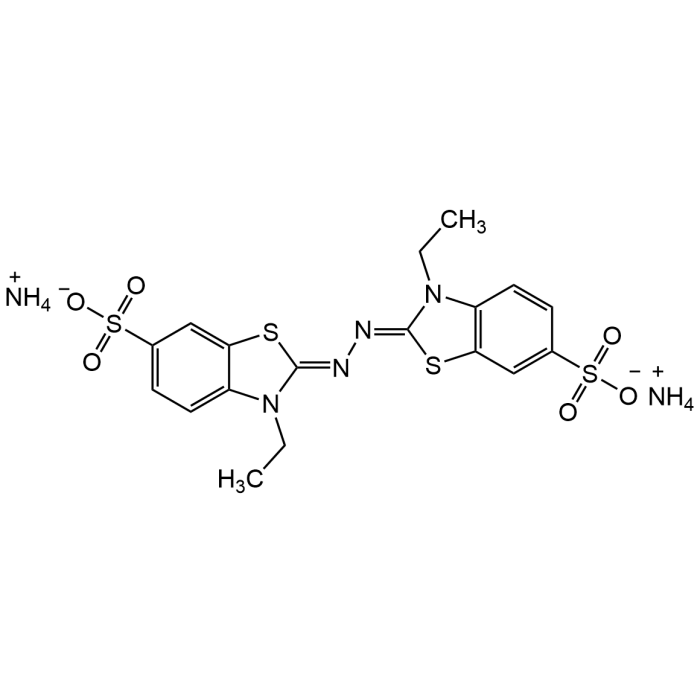Cookie Policy: This site uses cookies to improve your experience. You can find out more about our use of cookies in our Privacy Policy. By continuing to browse this site you agree to our use of cookies.
Chemodex
ABTS diammonium salt
As low as
52
CHF
CHF 52.00
In stock
Only %1 left
CDX-A0591-G0011 gCHF 52.00
CDX-A0591-G0055 gCHF 206.00

| Product Details | |
|---|---|
| Synonyms | AzBTS-(NH4)2; 2,2'-Azino-bis(3-ethylbenzothiazoline-6-sulfonic acid) diammonium salt; Diammonium 2,2?-azinobis(3-ethyl-6-benzothiazolinesulfonate) |
| Product Type | Chemical |
| Properties | |
| Formula | C18H16N4O6S4 . 2NH4 |
| MW | 548.68 |
| CAS | 30931-67-0 |
| RTECS | DL7002000 |
| Source/Host Chemicals | Synthetic |
| Purity Chemicals | ≥98% (HPLC) |
| Appearance | Faint green to yellow powder. |
| Solubility | Soluble in water (10mg/ml) or DMSO (10mg/ml). |
| Identity | Determined by 1H-NMR. |
| Declaration | Manufactured by Chemodex. |
| Other Product Data |
Click here for Original Manufacturer Product Datasheet |
| InChi Key | OHDRQQURAXLVGJ-AXMZSLBLSA-N |
| Smiles | C(C)N1C=2C(SC1=NN=C3N(CC)C=4C(S3)=CC(S(=O)(=O)O)=CC4)=CC(S(=O)(=O)O)=CC2.N |
| Shipping and Handling | |
| Shipping | AMBIENT |
| Short Term Storage | +20°C |
| Long Term Storage | +4°C |
| Handling Advice | Protect from light and moisture. |
| Use/Stability | Stable for at least 2 years after receipt when stored at +4°C. |
| Documents | |
| Product Specification Sheet | |
| Datasheet |
 Download PDF Download PDF |
Description
ABTS (2,2' -Azino-bis-(3-ethylbenzothiazoline-6-sulfonic acid), diammonium salt) is a very sensitive chromogenic peroxidase substrate (including horseradish peroxidase (HRP)) widely used for ELISA applications. The substrate yields a water-soluble green colored product that can be quantified by colorimetric detection at 405 nm. The reaction may be stopped with 1% sodium dodecyl sulfate (SDS). It has commonly been used to assess antioxidant capacity in the Trolox equivalent antioxidant capacity (TEAC) assay. It has a blue color in the presence of sodium persulfate or metmyoglobin but decolorizes upon incubation with antioxidants, and the antioxidant capacity can be determined spectrophotometrically. ABTS is significantly used by the food industry, to measure the antioxidant capacities within different foods. ABTS is also used to monitor glucose concentrations in different solutions including blood serum and as a safe alternative to DAB for the enhancement of blood fingerprints.
Product References
(1) R.E. Childs & W.G. Bardsley; Biochem. J. 145, 93 (1975) | (2) N.P. Groome; J. Clin. Chem. Clin. Biochem. 18, 345 (1980) | (3) E. Engvall; Meth. Enzymol 70, 419 (1980) | (4) E. Al-Kaissi & A. Mostratos; J. Immunol. Methods. 58, 127 (1983) | (5) A. Szutowicz, et al.; Anal. Biochem. 138, 86 (1984) | (6) N.J. Miller & C.A. Rice-Evans; Free Radic. Res. 26, 195 (1997) | (7) J.P. Caldwell, et al.; J. Forensic Sci. 45, 785 (2000) | (8) D. Huang, et al.; J. Agric. Food Chem. 53, 1841 (2005) | (9) A. Reyna-Bello, et al.; J. Immunoassay Immunochem. 28, 1 (2007) | (10) R.B. Walker & J.D. Everette; J. Agric. Food Chem. 57, 1156 (2009) | (11) A.A. Salem, et al.; Anal. Chem. Insights 6, 37 (2011) | (12) Y. Li, et al.; Spectrochim. Acta A Mol. Biomol. Spectrosc. 173, 880 (2017) | (13) A. Liberato, et al.; Inorg. Chem. 57, 14471 (2018)





